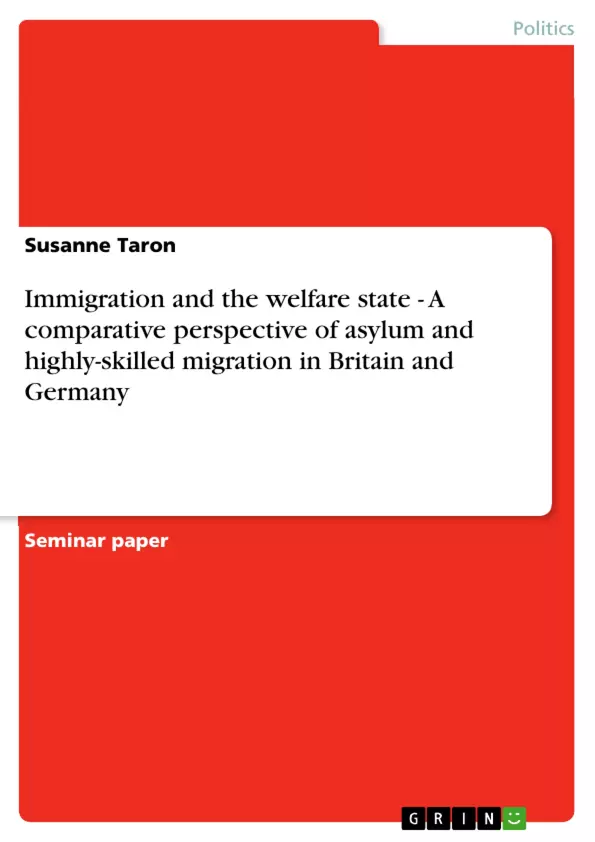Armed conflict, economic despair, and systematic violations of human rights have produced unprecedented challenges to today’s international system. It is thus; the post-Cold War era has become witness to significant alterations in global politics that has subsequently generated acute increases in the number of worldwide migrants. Consequently, it is the relationship staggered between immigration and welfare that continues to become an increasingly salient European affair. Immigration continues to remain a contentious issue spawning vigorous debates intensely focused on welfare and social rights. Areimmigrants likely to make positive contributions to welfare states? Or are immigrants rather liable to be a threat, posingfinancial, social and political burdens, and an overall risk to the survival of these welfare states? Underpinning these ubiquitousquestions has been a realignment of debates about the needs and resources of European welfare states, with the renewed interest in immigration as a means of offsetting skills and labour market shortages, while countering the effects of a demographicallyaging European population.1Immigration additionally has beenviewed as a means in achieving the European Union’s ambitious Lisbon targets, in that Europe “would become the most competitive and dynamic knowledge-based economy in the world, capable of sustainable economic growth with more and better jobs and greater social cohesion”.2Yet as with most social issues, the simple term ‘immigration’ fails to do justice to the wide range of issues that this policy area entails. In fact, there is much to be said about the composition of immigrants, and it would be a huge oversight to classify immigration as though it were homogenous. An acute distinction must be drawn between ‘desired’ and ‘undesired’ forms of immigration, in the ways in which debates about needs and resources have been recast in Europe. Indeed, it seems that through this differentiation, European welfare states have pursued a janus-headed approach to immigration, in that European welfare states continue to open their doors, to highly-skilled immigrants, deemed as positive, but on the otherhand have continued to vigorously close their doors, particularly to asylum immigrants, which have become increasingly unwanted and the source of restrictive polices.
Inhaltsverzeichnis (Table of Contents)
- Introduction.
- Defining immigration and welfare
- Highly-skilled immigration
- Asylum immigration
- Historically, two very different countries: types of migration and forms of the welfare state
- Britain
- Germany
- Comparing and contrasting citizenship
- The significance of citizenship
- Asylum immigration: what is really happening?
- Towards an EU common immigration and asylum policy: does the Treaty of Amsterdam or Tampere actually make a difference?
- Conclusion
Zielsetzung und Themenschwerpunkte (Objectives and Key Themes)
This text aims to explore the complex relationship between immigration and the welfare state in a comparative perspective, focusing on asylum and highly-skilled migration in Britain and Germany.
- The impact of immigration on European welfare states
- The differentiation between 'desired' and 'undesired' forms of immigration
- The role of citizenship in shaping access to welfare benefits
- The contrasting approaches to immigration and welfare in Britain and Germany
- The potential impact of EU policies on immigration and asylum
Zusammenfassung der Kapitel (Chapter Summaries)
- Introduction: This chapter sets the stage by outlining the increasing significance of immigration and welfare in the post-Cold War era. It highlights the contrasting views on immigration and its potential impact on welfare states, emphasizing the distinction between highly-skilled and asylum immigration.
- Defining immigration and welfare: This chapter delves into the different types of immigration, specifically focusing on highly-skilled and asylum immigration. It analyzes the potential benefits and challenges associated with each category.
- Historically, two very different countries: types of migration and forms of the welfare state: This chapter compares and contrasts the historical immigration patterns and welfare state models of Britain and Germany. It explores the unique factors shaping their respective approaches to immigration.
- Comparing and contrasting citizenship: This chapter examines the role of citizenship in shaping access to welfare benefits in both Britain and Germany. It explores the different legal frameworks and policies surrounding citizenship and its implications for immigrants.
- The significance of citizenship: This chapter delves deeper into the significance of citizenship in the context of immigration and welfare, analyzing its impact on the integration and inclusion of immigrants into society.
- Asylum immigration: what is really happening?: This chapter explores the complex realities of asylum immigration in both countries, analyzing the challenges faced by asylum seekers and the responses of the respective welfare states.
- Towards an EU common immigration and asylum policy: does the Treaty of Amsterdam or Tampere actually make a difference?: This chapter analyzes the impact of European Union policies on immigration and asylum. It examines whether the Treaty of Amsterdam or Tampere has effectively addressed the challenges of managing immigration across Europe.
Schlüsselwörter (Keywords)
This text focuses on key concepts such as immigration, welfare state, asylum, highly-skilled migration, citizenship, integration, inclusion, Britain, Germany, European Union, and comparative analysis. It explores the complex interplay of these elements in shaping the relationship between immigration and the welfare state.
- Arbeit zitieren
- Susanne Taron (Autor:in), 2006, Immigration and the welfare state - A comparative perspective of asylum and highly-skilled migration in Britain and Germany , München, GRIN Verlag, https://www.grin.com/document/64596



